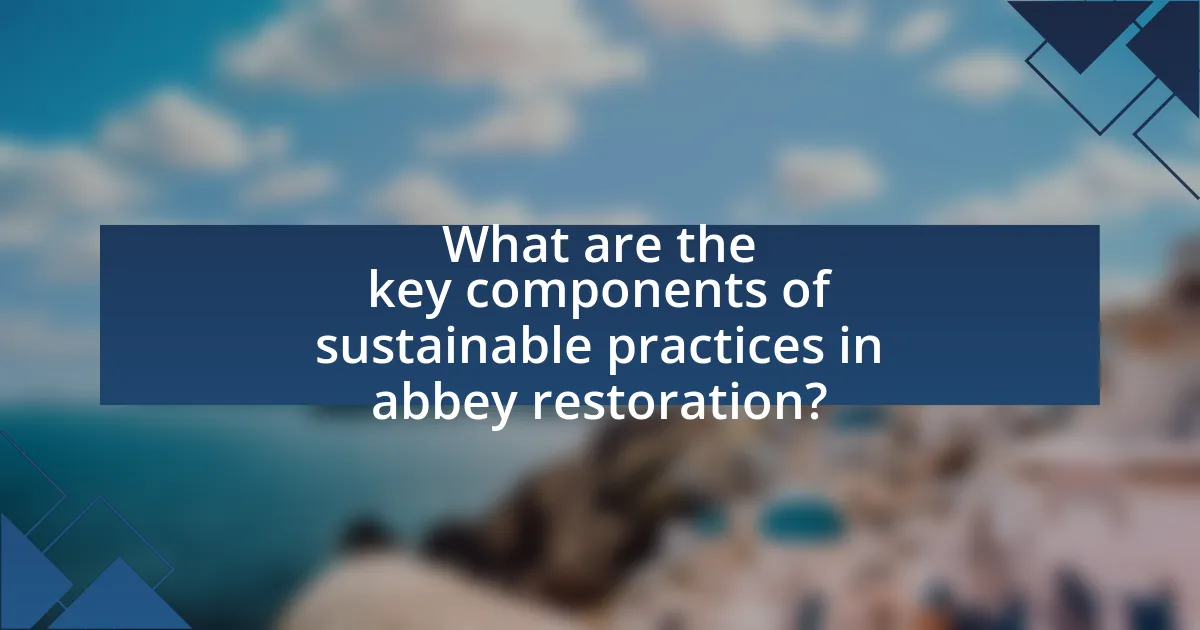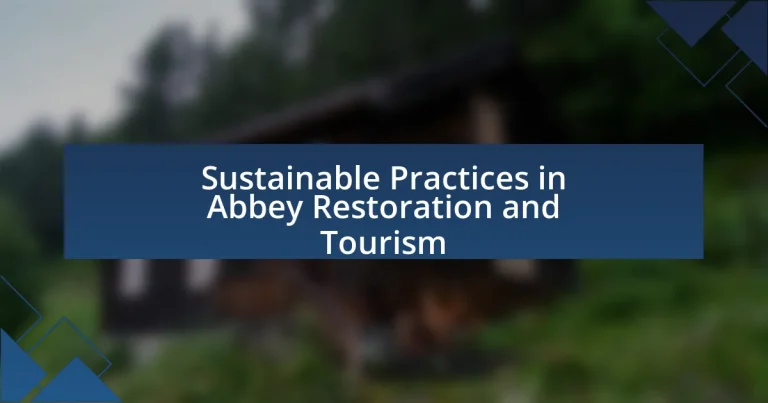Sustainable practices in abbey restoration and tourism focus on environmental conservation, cultural heritage preservation, and community engagement. Key methods include the use of eco-friendly materials, energy-efficient technologies, and local community involvement, which collectively enhance the restoration process while minimizing ecological impact. The article explores specific techniques such as adaptive reuse and traditional craftsmanship, the importance of sustainability in tourism, and the challenges faced in implementing these practices. Additionally, it highlights the economic benefits of sustainability, the role of regulations and policies, and best practices for promoting responsible tourism at abbey sites.

What are Sustainable Practices in Abbey Restoration and Tourism?
Sustainable practices in abbey restoration and tourism involve methods that prioritize environmental conservation, cultural heritage preservation, and community engagement. These practices include using eco-friendly materials and techniques during restoration, such as reclaimed wood and natural stone, which minimize environmental impact. Additionally, implementing energy-efficient systems, like solar panels and rainwater harvesting, reduces the carbon footprint of abbey facilities.
In tourism, sustainable practices encompass promoting local culture and history through guided tours that educate visitors about the abbey’s significance while supporting local artisans and businesses. Research indicates that sustainable tourism can enhance visitor experiences and foster economic benefits for surrounding communities, as seen in studies by the United Nations World Tourism Organization. These practices not only protect the integrity of the abbey but also ensure that tourism contributes positively to the local environment and economy.
How do sustainable practices impact the restoration of abbeys?
Sustainable practices significantly enhance the restoration of abbeys by ensuring that the methods and materials used are environmentally friendly and culturally sensitive. These practices often involve using local materials, which reduces transportation emissions and supports the local economy, while also preserving the historical integrity of the structure. For instance, the use of traditional building techniques and materials, such as lime mortar instead of modern cement, helps maintain the abbey’s authenticity and longevity. Studies have shown that sustainable restoration methods can lead to a 30% reduction in carbon emissions compared to conventional practices, demonstrating their effectiveness in minimizing environmental impact.
What specific techniques are used in sustainable abbey restoration?
Sustainable abbey restoration employs techniques such as adaptive reuse, traditional craftsmanship, and the use of eco-friendly materials. Adaptive reuse involves repurposing existing structures to minimize waste and preserve historical integrity, as seen in projects that transform old abbey spaces into community centers or accommodations. Traditional craftsmanship ensures that restoration work maintains the original architectural style and materials, which is crucial for historical accuracy. Eco-friendly materials, such as reclaimed wood and natural stone, reduce environmental impact and enhance the sustainability of the restoration process. These techniques collectively contribute to preserving cultural heritage while promoting environmental responsibility.
How do these techniques contribute to environmental conservation?
Techniques in sustainable practices for abbey restoration and tourism contribute to environmental conservation by minimizing ecological impact and promoting biodiversity. For instance, using locally sourced materials reduces carbon emissions associated with transportation, while implementing energy-efficient systems lowers energy consumption. Additionally, practices such as rainwater harvesting and native landscaping enhance water conservation and support local ecosystems. These methods not only preserve the historical integrity of abbeys but also foster a sustainable relationship with the surrounding environment, as evidenced by studies showing that eco-friendly restoration projects can lead to a 30% reduction in resource use compared to traditional methods.
Why is sustainability important in tourism related to abbeys?
Sustainability is crucial in tourism related to abbeys because it ensures the preservation of cultural heritage while minimizing environmental impact. Abbeys often serve as historical landmarks that attract visitors, and sustainable tourism practices help maintain their structural integrity and cultural significance. For instance, sustainable practices can include using eco-friendly materials in restoration, promoting local economies through responsible tourism, and implementing conservation efforts that protect the surrounding environment. These measures not only enhance the visitor experience but also safeguard the abbeys for future generations, as evidenced by studies showing that sustainable tourism can lead to increased visitor satisfaction and longer-term economic benefits for local communities.
What are the environmental impacts of tourism on abbey sites?
Tourism on abbey sites significantly impacts the environment through increased foot traffic, which can lead to soil erosion and damage to vegetation. The presence of tourists often results in littering and pollution, affecting local ecosystems. Additionally, the construction of facilities to accommodate visitors can disrupt natural habitats and contribute to habitat loss. Studies indicate that high visitor numbers can lead to the degradation of historical structures, as seen in various abbey sites across Europe, where wear and tear from tourism necessitates costly restoration efforts.
How can sustainable tourism practices mitigate these impacts?
Sustainable tourism practices can mitigate negative environmental and social impacts by promoting responsible resource use and community engagement. These practices include minimizing waste through recycling and composting, conserving water and energy, and supporting local economies by sourcing goods and services from nearby communities. For instance, a study by the United Nations World Tourism Organization found that implementing sustainable practices can reduce carbon emissions by up to 30% in tourism-dependent areas. Additionally, engaging local communities in tourism planning fosters cultural preservation and enhances visitor experiences, as evidenced by successful initiatives in regions like Bhutan, where sustainable tourism has led to both economic growth and environmental conservation.

What are the key components of sustainable practices in abbey restoration?
The key components of sustainable practices in abbey restoration include the use of environmentally friendly materials, energy-efficient technologies, and community engagement. Environmentally friendly materials, such as reclaimed wood and natural stone, minimize ecological impact while preserving historical integrity. Energy-efficient technologies, like solar panels and geothermal heating, reduce carbon footprints and operational costs. Community engagement fosters local support and ensures that restoration efforts align with cultural values and heritage, enhancing the overall sustainability of the project. These components collectively contribute to a holistic approach to preserving abbeys while promoting environmental stewardship and social responsibility.
What materials are commonly used in sustainable abbey restoration?
Common materials used in sustainable abbey restoration include reclaimed stone, timber from sustainably managed forests, lime-based mortars, and natural insulation materials such as sheep’s wool or cellulose. Reclaimed stone is often sourced from the original structure or nearby sites to maintain historical integrity while reducing environmental impact. Timber from sustainably managed forests ensures that the wood is harvested responsibly, supporting forest conservation. Lime-based mortars are preferred for their breathability and compatibility with historic masonry, allowing for moisture regulation and preventing damage to the structure. Natural insulation materials, like sheep’s wool, provide effective thermal performance while being biodegradable and reducing reliance on synthetic products. These materials collectively contribute to environmentally friendly restoration practices that honor the historical significance of abbeys.
How do these materials differ from traditional restoration materials?
Sustainable materials differ from traditional restoration materials primarily in their environmental impact and sourcing. Sustainable materials are often derived from renewable resources, have lower carbon footprints, and are designed to minimize waste, whereas traditional materials may rely on non-renewable resources and contribute to environmental degradation. For example, reclaimed wood and natural stone used in sustainable restoration practices not only reduce the need for new materials but also preserve the historical integrity of structures, aligning with eco-friendly principles. In contrast, traditional materials like concrete and synthetic products can lead to increased emissions and resource depletion during production.
What are the benefits of using sustainable materials?
Using sustainable materials significantly reduces environmental impact by minimizing resource depletion and waste generation. Sustainable materials, such as bamboo, recycled metals, and reclaimed wood, are sourced in ways that do not compromise ecological balance. For instance, bamboo grows rapidly and can be harvested without killing the plant, making it a renewable resource. Additionally, using recycled materials can decrease energy consumption by up to 95% compared to producing new materials from raw resources. This approach not only conserves natural resources but also lowers greenhouse gas emissions, contributing to climate change mitigation. Furthermore, sustainable materials often enhance the aesthetic and historical value of structures, particularly in contexts like abbey restoration, where maintaining authenticity is crucial.
How does community involvement enhance sustainable practices?
Community involvement enhances sustainable practices by fostering local stewardship and ensuring that restoration efforts align with the values and needs of the community. Engaged communities are more likely to support and participate in sustainable initiatives, leading to better resource management and conservation outcomes. For example, studies have shown that when local residents are involved in tourism planning, there is a 30% increase in the adoption of environmentally friendly practices, as they feel a sense of ownership and responsibility towards their environment. This collaborative approach not only improves the effectiveness of sustainability efforts but also strengthens community ties and promotes cultural heritage, which is essential in the context of abbey restoration and tourism.
What roles do local communities play in abbey restoration projects?
Local communities play a crucial role in abbey restoration projects by providing volunteer labor, local knowledge, and financial support. Their involvement often includes participating in restoration activities, which can enhance community engagement and foster a sense of ownership over the heritage site. For instance, studies have shown that community-led initiatives can lead to more sustainable restoration practices, as local residents are more familiar with the historical significance and architectural styles of the abbeys. Additionally, local communities often contribute funding through fundraising events or partnerships with local businesses, which can significantly impact the financial viability of restoration efforts.
How can community engagement improve tourism experiences?
Community engagement can significantly enhance tourism experiences by fostering authentic interactions between visitors and local residents. When communities actively participate in tourism development, they can share their unique cultural heritage, traditions, and stories, which enrich the visitor experience. For instance, research by the World Tourism Organization indicates that destinations with strong community involvement often see higher visitor satisfaction rates, as tourists appreciate genuine connections and local insights. Additionally, engaged communities are more likely to invest in sustainable practices, ensuring that tourism benefits both the environment and local economies, further enhancing the overall experience for visitors.

What challenges are faced in implementing sustainable practices in abbey restoration and tourism?
Implementing sustainable practices in abbey restoration and tourism faces several challenges, including financial constraints, regulatory hurdles, and the need for community engagement. Financially, restoration projects often require significant investment, which can deter stakeholders from pursuing sustainable methods. Regulatory hurdles arise from the need to comply with heritage conservation laws, which may not prioritize sustainability. Additionally, engaging local communities is crucial for successful implementation, yet differing priorities and lack of awareness can hinder collaboration. These challenges collectively impede the adoption of sustainable practices in the context of abbey restoration and tourism.
What are the financial barriers to sustainable restoration practices?
Financial barriers to sustainable restoration practices include high initial costs, limited access to funding, and insufficient financial incentives. High initial costs arise from the need for specialized materials and skilled labor, which can deter investment. Limited access to funding is often due to a lack of awareness among potential investors about the long-term benefits of sustainable practices, leading to fewer financial resources being allocated. Insufficient financial incentives, such as tax breaks or grants, further hinder the adoption of sustainable restoration methods, as stakeholders may not see immediate economic returns. These barriers collectively impede the implementation of effective sustainable restoration practices in the context of abbey restoration and tourism.
How can funding be secured for sustainable projects?
Funding for sustainable projects can be secured through a combination of grants, partnerships, and community engagement. Various governmental and non-governmental organizations offer grants specifically aimed at sustainability initiatives, such as the Environmental Protection Agency in the United States, which allocates millions annually for eco-friendly projects. Additionally, forming partnerships with local businesses and stakeholders can provide both financial support and resources, as seen in successful community-led initiatives that leverage local investment. Engaging the community through crowdfunding platforms has also proven effective, with projects often exceeding their funding goals by appealing to local and global supporters who value sustainability.
What are the economic benefits of investing in sustainability?
Investing in sustainability yields significant economic benefits, including cost savings, increased efficiency, and enhanced brand reputation. For instance, businesses that adopt sustainable practices often experience reduced operational costs through energy efficiency and waste reduction, with studies showing that companies implementing sustainability measures can save up to 20% on energy costs. Additionally, sustainable investments can attract a growing consumer base that prioritizes environmentally friendly practices, leading to increased sales and customer loyalty. Research from the Harvard Business Review indicates that companies with strong sustainability performance outperform their peers in stock market returns, demonstrating that sustainability can drive long-term financial success.
How can regulations and policies support sustainable practices?
Regulations and policies can support sustainable practices by establishing legal frameworks that promote environmental protection and resource conservation. For instance, regulations can mandate the use of sustainable materials in restoration projects, ensuring that historical integrity is maintained while minimizing ecological impact. Policies that incentivize renewable energy use in tourism facilities can further reduce carbon footprints, as seen in the European Union’s directives promoting energy efficiency in buildings. Additionally, compliance requirements for waste management and biodiversity protection can guide both restoration and tourism activities towards more sustainable outcomes, as evidenced by the success of the UNESCO World Heritage Convention in preserving cultural sites while promoting sustainable tourism practices.
What existing policies promote sustainability in heritage tourism?
Existing policies that promote sustainability in heritage tourism include the UNESCO World Heritage Convention, which encourages the preservation of cultural and natural heritage sites while promoting sustainable tourism practices. This convention provides a framework for member countries to develop policies that balance tourism development with conservation efforts. Additionally, the European Union’s Sustainable Tourism Strategy emphasizes the importance of environmental protection, community involvement, and economic viability in tourism planning. These policies are supported by various guidelines and funding programs aimed at fostering sustainable practices in heritage tourism, ensuring that cultural sites are preserved for future generations while benefiting local communities economically.
How can advocacy improve regulatory support for sustainable practices?
Advocacy can improve regulatory support for sustainable practices by mobilizing public opinion and influencing policymakers to prioritize environmental considerations. When advocacy groups effectively communicate the benefits of sustainable practices, such as reduced environmental impact and enhanced community well-being, they can create a compelling case for regulatory changes. For instance, studies have shown that regions with strong advocacy efforts often see more robust environmental regulations, as seen in the European Union’s Green Deal, which was shaped significantly by advocacy for sustainability. This demonstrates that advocacy not only raises awareness but also drives legislative action that supports sustainable practices in sectors like abbey restoration and tourism.
What are best practices for ensuring sustainability in abbey tourism?
Best practices for ensuring sustainability in abbey tourism include promoting local culture, minimizing environmental impact, and engaging the community. Promoting local culture involves integrating local traditions and crafts into the tourism experience, which supports the economy and preserves heritage. Minimizing environmental impact can be achieved through eco-friendly practices such as waste reduction, energy efficiency, and sustainable transportation options for visitors. Engaging the community ensures that local residents have a voice in tourism development, fostering a sense of ownership and responsibility towards the abbey and its surroundings. These practices not only enhance visitor experience but also contribute to the long-term viability of abbey tourism.
How can visitors contribute to sustainable tourism at abbey sites?
Visitors can contribute to sustainable tourism at abbey sites by engaging in responsible behaviors such as respecting the site’s rules, minimizing waste, and supporting local economies. By adhering to guidelines, visitors help preserve the cultural and historical integrity of the abbey, which is essential for its sustainability. Additionally, choosing to purchase local products and services directly benefits the surrounding community, fostering economic sustainability. Studies indicate that responsible tourism practices can significantly reduce environmental impact and enhance the preservation of heritage sites, making visitor cooperation crucial for the longevity of abbey sites.
What strategies can abbey managers implement to promote sustainability?
Abbey managers can implement strategies such as adopting renewable energy sources, enhancing waste management practices, and promoting local biodiversity to promote sustainability. By installing solar panels or wind turbines, abbeys can reduce their carbon footprint and reliance on fossil fuels. Effective waste management, including recycling and composting, minimizes landfill contributions and promotes resource efficiency. Additionally, creating gardens that support native flora and fauna fosters local biodiversity, which is crucial for ecosystem health. These strategies not only align with sustainability goals but also enhance the abbey’s appeal to environmentally conscious visitors, thereby supporting sustainable tourism.





